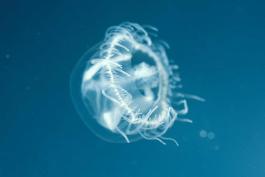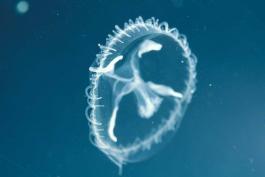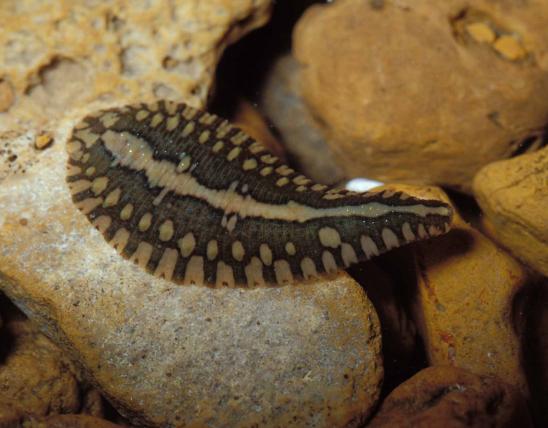
This jellyfish has two life phases, a polyp form and a medusa form, each giving “birth” to the other.
The polyp is tiny and sessile (attached to a surface; not free-floating), like a very simple sea anemone or hydroid with only a few branches. The polyps form buds on their sides that separate to become new individuals. In this way, the polyps can form in colonies.
Most of the year, this jellyfish species is usually present only in the polyp form (or in a dormant, tiny, seedlike resting form called a podocyst). These are little seen or noticed, but they tolerate a wide range of temperatures.
The free-swimming medusa phase has the typical jellyfish form: an umbrella-like body with a stomach (manubrium) extending downward from the center. At the bottom of the manubrium is the mouth opening, with 4 frilly lobes. A fringe of up to 400 tentacles lines the edge of the “umbrella.” This creature is transparent or translucent, sometimes faintly tinted tan, gray, white, green, or blue. Four white, opaque patches sometimes appear in the body; these are the gonads (organs that produce sperm and eggs).
Although in our state the medusa form only occurs during mid to late summer, when surface waters reach about 80F, it is nevertheless the most commonly seen phase of this animal, due to its size and location near the water surface.

Habitat and Conservation
These delicate creatures are gentle swimmers and cannot tolerate much of a current, so they usually occur in calm or standing waters. They are most often found in ponds, lakes, reservoirs, and quiet or sluggish pools next to flowing water. They usually float just below the surface and when they appear are often seen in great numbers. They swim by pulsating contractions of the bell-like body.
The native range of this species is eastern Asia (specifically, the Yangtze River valley), but it has been transported around the world and now has a global distribution (in appropriate habitats). Considering that the polyp stage of this animal adheres to objects such as submerged plants, it is easy to see how it could have been imported to Europe, North America, and elsewhere as a hidden passenger on ornamental aquatic plants such as Chinese water lilies and water hyacinths. The podocyst resting stage, like tiny seeds, may also be easily transported from place to place. This species may also have spread, in part, by being included in the water with stocked (moved) fish, or even on the feet of migrating birds, among other possible modes of transfer.
Food
Status
In Missouri, common but sporadic in occurrence. Usually, people only see the medusa stage, from July through September, when the surface of the water reaches about 80F.
This species started to be found in England and North America in the late 1800s and mainland Europe in the early 1900s. It has been found in at least 44 US states. It is difficult for researchers to measure populations of this animal, because it apparently spends most of its time in the hard-to-see polyp and podocyst stages. In many places, the more noticeable medusa form may only appear in the summers of certain years.
Life Cycle
Human Connections
Will these jellyfish sting like their marine cousins? The answer is yes and no: They do have the same basic “stinging cells” on the tentacles (used for feeding), but these probably cannot penetrate human skin. A few people have reported itching or redness, but most people don’t feel them at all.
The story of this animal's spread reminds us how easy it is to accidentally transport unwanted organisms if we move plants, animals, or even water from one place to another. In this case, the transplanted jellyfish has not proven to be destructive to our native ecosystems, but with other nonnative introductions, the results have been devastating. Never dump aquarium contents, ornamental aquatic plants, or bait into native waters.
Ecosystem Connections
Most of us know that tiny plants and animals form the base of the food chain. Freshwater jellies are a link between the microscopic animals they eat, and their own predators, which are big enough for us to see without magnification.
Some types of crayfish eat this jellyfish, but fish apparently do not eat them.
The ecological impacts of this nonnative species are unclear. It is possible that, during large population "blooms" of these jellyfish, they could have a significant impact on the planktonic organisms they eat, with a single medusa eating nearly 200 planktonic animals a day. More research is needed. If these jellyfish were to cause a major decline in planktonic algae, daphnia, and other organisms that form the basis of aquatic food chains, they might indeed have an indirect impact on populations of fish and other larger animals. However, their blooms tend to be only sporadic, when water surface temperatures reach about 80F and remain that warm for an extended time.
Although this is an introduced, nonnative species, it apparently, so far, seems to do little harm to natural ecosystems, and its occasional population explosions seem to cause no lasting impact.































